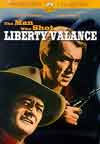The Man Who Shot Liberty Valance
Paramount Home Video
Cast: John Wayne, James Stewart, Lee Marvin, Vera Miles
Extras: Theatrical Trailer
Rating:
’The Man Who Shot Liberty Valance’ is a classic Western from one of the masters of the genre, John Ford. Starring John Wayne, James Stewart, Lee Marvin and Vera Miles, this has certainly been a star-studded vehicle for its time, and the result is as satisfying as the premise is promising. ’The Man Who Shot Liberty Valance’ is one of those rare Westerns that tell a story in a way you won’t forget. With elements of conspiracy, characters that run the entire gamut of personalities and traits and a cinematography that often resembles a Film Noir, this movie is a landmark of the Western genre.
The DVD of ’The Man Who Shot Liberty Valance’ is presented in a glorious anamorphic widescreen transfer in the movie’s original 1.85:1 aspect ratio. The transfer itself is extremely clean and without noise, but most importantly, devoid of any blemishes or damages. It is obvious that Paramount did some work on this transfer in order to such a clean and stable presentation. Presented in black and white, the contrast of the film is perfect, with very deep blacks and good highlights that never bloom. The gradient of the gray scale the image conveys is beautifully balanced, creating an image that has depth and a richness the brings out all the subtle nuances in the photography and the elaborate production design. The transfer is virtually free of edge-enhancement and the result is an image that is finely delineated and highly detailed, yet never appears exaggerated or overly sharpened. The compression is flawless without introducing any artifacts of sorts. In a word, this is a marvelous treatment of a classic film that makes you wish every vintage film could look like!
The DVD also contains a newly remixed 5.1 channel Dolby Digital audio track, alongside the movie’s original monaural track. It is a surprising constellation, because Paramount traditionally shies away from remixing audio tracks. I am all for it, but I guess with that in mind, the studio no longer has a valid excuse not to similarly treat other films where poor audio performance certainly has been an issue. The remixed track is very good, although surround usage is limited for obvious reasons. The frequency response has been corrected however, resulting in a track that is much more life-like than the narrow-banded mono track. Natural sounding and with good dynamic range, this is a good example how a restored and remixed audio track can increase the experience of a classic movie without necessarily affecting its artistic integrity.







